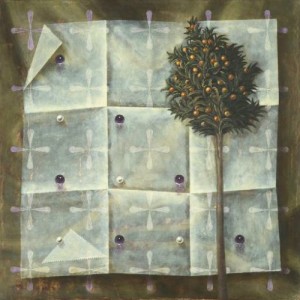Introductory essay for the catalog of an exhibit of her work at Stephen Ongpin Fine Art, November 2009.

Eclogue, by Anne Connell
Meticulous precision is a quality often associated with the machine age, but an equally exact manual execution reached and passed its apotheosis long before the first steam engine met its track. Such sharp perfection, born of infinite patience, relates to a time when creativity was not strongly associated with chaos, as it is in modern psychodynamic thought. Though Anne Connell’s exquisite paintings draw on this old-fashioned idea of ingenious order, and though they incorporate elements of specific antique paintings that the artist admires, they are neither post-modernist nor appropriationist, because their purpose is neither to comment on the transcience of history nor to reflect the fallacy of authorship. Their impact is visual rather than conceptual, but they contain a wistful philosophy; they suggest a continuity that encompasses the continuity of loss. Though they are sometimes playful, they are also mystical. That shimmering, smooth surface, the decorative elements that rise sensually from the picture plane. the elegant fragments that seem almost flirtatiously to ask why and how they were selected, all seduce without giving away their secrets. You see at once that the work is beautiful, but you can tell that it is not simply about its own beauty.
If what these paintings have to tell us could be translated into words, Anne Connell, a capable wordsmith, would have translated it. No — what we find in her orderly compositions is something profound and inchoate, an exquisite longing for how things were when they were better, a yearning that is entirely contemporary, the present moment’s insistence on precedents. If Anne Connell had lived in the Renaissance, her work would have used elements from Praxiteles, and if she’d been in fifth-century Athens, she’d have found her way to cave paintings, and the effect would have been identical, because her work is not about any particular past; it is about the sad, humorous, reassuring fact of the past itself.











